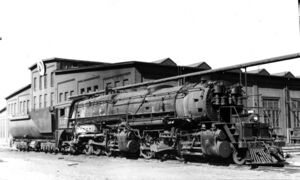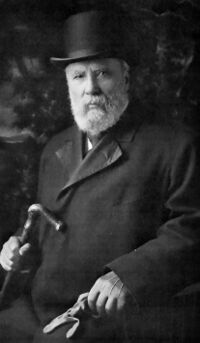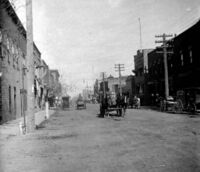2018-12-02-nostalgia-magazine-p1b-how-hillyard-became-a-city
December 02, 2018 Nostalgia Magazine Page 1b:
How Hillyard Became A City Against Its Better Judgment and Relectantly Stayed One for 29 Years
By Chet Caskey
The story of when Hillyard became incorporated as a city is a fascinating and hilarious one. The main line of the Great Northern Railway, owned and operated by the so-called “Empire Builder” James Jerome Hill, reached Spokane on June 1, 1892. East of the City of Spokane, a large flat plain, originally called Horse Plains by early fur traders, was selected to be a major freight, roundhouse and repair facility for the railway. The railway named this spot the “East Spokane Station,” and early suggestions to name the station after Mr. Hill were dismissed by the Empire Builder as out of the question. Mr. Hill was very proud of his name. Originally christened simply “James Hill”, at age thirteen in 1851, he adopted the middle name of “Jerome” after Napoleon Bonaparte’s brother in admiration of the French conqueror and his family. “The Great Man” did not want his name associated with a lowly railway station. As yard construction began at the East Spokane Station, a small group of supporting businesses grew up on the west side of the tracks, informally called “Hill’s Yard.” By plat dated October 25, 1892, Leland and Kate Westfall first laid out a potential town at the site, which they christened “Hillyard,” but their early attempts at incorporation were in vain. James Hill had personally visited Horse Plains in the planning stage of the railway, and had specifically picked the area for a train yard to be five miles away from the City of Spokane (and its taxes). His representatives forbade the formal incorporation of the town. Nevertheless, a post office was soon established at the site, which carried the name “Hillyard.”
By 1895 the unincorporated village of Hillyard had 486 permanent residents, and the issue of incorporation again raised its defiant head to the railway. On August 12, 1895, the several hundred residents of Hillyard voted to incorporate their little city, and the secretary of the meeting forwarded on the results of the election to the Washington Secretary of State for recordation. In debating incorporation, alternative names to Hillyard were suggested, such as North Spokane, Liberty, and Omaha – but the customary place name of Hillyard prevailed for the vote. However, word of the incorporation plan had already gotten back to the Empire Builder – an incorporation idea he had specifically forbade taking place three years earlier in 1892. By letter dated October 5, 1895, the leadership of the new city received a copy of the following instructions that Mr. Hill had written to the railway’s local agent. It stated in material part:
“ . . if it is decided to incorporate the town of Hillyard we will at once move our shops from that point. This we can very readily do at comparatively small expense; and if the agitation for incorporation continues we may very likely move the shops in any event.”
Thus, Mr. Hill was threatening not only to move the station if the settlement voted to incorporate, but also even if the “agitation for incorporation” continued. Oops! The citizens had already voted to incorporate! Terrified that the Empire Builder was exactly the man of his word his reputation suggested, the incorporation committee threw all evidence of the incorporation meeting and vote away, and they apparently agreed among themselves not even to “agitate” for incorporation in the future.
However, time has a way of blurring memories. After 10 years of wisely omitting any moves toward or even “agitation” for incorporation, the issue again became a preoccupation of the citizens of Hillyard. By 1904, the population of Hillyard had grown to over 2,000, and with the population growth came serious problems of water shortages, questions of fire protection, and complaints about the quality of the community’s school.
The first and most popular solution proposed was to be annexed to the City of Spokane. Originally five miles away from Spokane, the larger city had now grown until it was almost contiguous with Hillyard. On August 26, 1904, a mass meeting of residents in Hillyard voted to be annexed to Spokane – or to at least submit the proposal to the Spokane City Council. In response to the request, the City Council of Spokane politely declined to annex the community. Hillyard had too many – and expensive – problems. Water and fire protection with a good supply of water, were serious considerations.
Without incorporation there could be no taxation to pay for infrastructure, schools or even salaries for city re and police. Mindful of the Empire Builder’s wrath, after Spokane refused to annex it, plans were undertaken to incorporate the city, but to exclude all Great Northern property from the city limits (and potential taxation). Hopefully, this would appease the Empire Builder.
Yet there was a problem. The community of Hillyard now extended on both sides of the expansive Great Northern East Spokane Station yards. The incorporation proposal would have to be a plan of West and East Hillyard with a huge blank space in the middle of town to exclude the railway. An answer was proposed to build a tunnel under the huge yards to connect West and East Hillyard – because the railway certainly did not want roads intersecting its tracks in the yard itself. There is some evidence that work on the tunnel actually began – perhaps to boost the community’s bid to incorporate and make the attempt seem serious and practical. However, a major property owner on the east side of the station liked things just the way they were in “Dog Town”, and opposed the tunnel.
Then disaster struck for the thirsty and re-wary pro-incorporation advocates. On November 16, 1905, Spokane County Judge Poindexter ruled in a lawsuit attempting to block incorporation that the proposed plan to exclude the Great Northern property from the city limits and tax rolls was unconstitutional. The Judge ruled that any incorporation would have to include – and tax – the Great Northern property in the middle of the proposed city. It seemed highly unlikely that such a plan would be approved by the first citizen of the proposed City of Hillyard – Mr. Hill.
Then, in the darkest hour of Hillyard’s history – when all seemed lost – the clouds broke and the sun appeared. In a check of city incorporation records at the Washington Secretary of State’s office, it was discovered that the City of Hillyard was already incorporated and moreover had been for the last decade unbeknownst to the city fathers and mothers! It seems that the chairman of the incorporation committee back in 1895 had promptly sent in the results of the first incorporation vote to the Secretary of State’s office immediately after the vote had occurred and before the first citizens had received the Empire Builder’s infamous threat of October 5. While the city’s founders had immediately laid aside all evidence of incorporation after reading the letter, apparently the Secretary of State had not. As far as the State of Washington was concerned, Hillyard had been a legally incorporated city since August 12, 1895. Of course, it had neglected to tax its citizens, real estate, and businesses for a decade, had not built its much needed water system, and had not formed a fire department – but as far as the Secretary of State was concerned whether the libertarians of the City of Hillyard wanted to ignore taxation and city infrastructure was completely up to them. Hillyard was a legally incorporated city nonetheless.
By this time, the East Spokane Yard of the Great Northern Railway had grown so much from its beginnings in 1895 that it was no longer economically feasible for the Empire Builder to carry out his threat of moving. Hillyard was an “official” city. The Empire Builder could only grit his teeth when he heard that Hillyard was an incorporated city despite his wishes. In 1907, at age 69, the Empire Builder gave up his leadership of the Great Northern (although the railway stayed within the family). On Saturday, March, 16, 1907 – just for good measure and to supplement any missing supporting documents – the citizens of Hillyard voted for incorporation a second time with more land area added to the city’s limits.
Eastern Washington’s telephone books, city directories, tax records and other historical documents usually date the City of Hillyard from 1905, not from its incorporation in 1895. The reason, of course, is that the citizens of Hillyard only thought they lived in an incorporated city from 1905.
In actuality, the citizens of the City of Hillyard had obtained a rare gift from the stern and demanding Empire Builder’s threats in the last years of the 19th Century, a reprieve from municipal taxes and city elections for a full decade – not to mention the absence of patrolling policemen from the city’s numerous gambling dens, bars, and houses of ill-repute! It has been estimated that by 1904 as many as forty “women of the streets” were plying the oldest trade on the streets of Hillyard.
The voters of Hillyard were always split between the advantages and disadvantages of annexation to the City of Spokane as opposed to a separate city status. Perhaps they still are. In early 1924, the voters of Hillyard turned down a proposition to petition Spokane for annexation. The defeated pro-annexation group then went all out to organize a second vote later that year. On September 16, 1924, the proposal to petition Spokane (again) for annexation barely passed. To prevent a third vote from materializing, the pro-annexation forces immediately prepared an “emergency” petition for annexation and presented it to the Spokane City Council – who heard it on an emergency basis a week later (although – politics aside – one would have been hard pressed to think of what the “emergency” was). But for better or worse, the annexation petition was immediately passed, and on September 24, 1924, Hillyard became a part of the City of Spokane. The historic City of Hillyard, Washington, had been a ”city” for 29 years – one-third of the time of which it had not even been aware it was one!
Find Chet Caskey’s book, “Haunted Spokane” online at Amazon.com



